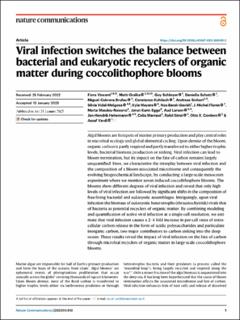| dc.contributor.author | Vincent, Flora | |
| dc.contributor.author | Gralka, Matti | |
| dc.contributor.author | Schleyer, Guy | |
| dc.contributor.author | Schatz, Daniella | |
| dc.contributor.author | Cabrera-Brufau, Miguel | |
| dc.contributor.author | Kuhlisch, Constanze | |
| dc.contributor.author | Sichert, Andreas | |
| dc.contributor.author | Vidal-Melgosa, Silvia | |
| dc.contributor.author | Mayers, Kyle | |
| dc.contributor.author | Barak-Gavish, Noa | |
| dc.contributor.author | Flores, J. Michel | |
| dc.contributor.author | Masdeu-Navarro, Marta | |
| dc.contributor.author | Egge, Jorun Karin | |
| dc.contributor.author | Larsen, Aud | |
| dc.contributor.author | Hehemann, Jan-Hendrik | |
| dc.contributor.author | Marrasé, Celia | |
| dc.contributor.author | Simó, Rafel | |
| dc.contributor.author | Cordero, Otto X. | |
| dc.contributor.author | Vardi, Assaf | |
| dc.date.accessioned | 2023-07-10T09:53:05Z | |
| dc.date.available | 2023-07-10T09:53:05Z | |
| dc.date.created | 2023-02-08T16:14:28Z | |
| dc.date.issued | 2023 | |
| dc.identifier.issn | 2041-1723 | |
| dc.identifier.uri | https://hdl.handle.net/11250/3077450 | |
| dc.description.abstract | Algal blooms are hotspots of marine primary production and play central roles in microbial ecology and global elemental cycling. Upon demise of the bloom, organic carbon is partly respired and partly transferred to either higher trophic levels, bacterial biomass production or sinking. Viral infection can lead to bloom termination, but its impact on the fate of carbon remains largely unquantified. Here, we characterize the interplay between viral infection and the composition of a bloom-associated microbiome and consequently the evolving biogeochemical landscape, by conducting a large-scale mesocosm experiment where we monitor seven induced coccolithophore blooms. The blooms show different degrees of viral infection and reveal that only high levels of viral infection are followed by significant shifts in the composition of free-living bacterial and eukaryotic assemblages. Intriguingly, upon viral infection the biomass of eukaryotic heterotrophs (thraustochytrids) rivals that of bacteria as potential recyclers of organic matter. By combining modeling and quantification of active viral infection at a single-cell resolution, we estimate that viral infection causes a 2–4 fold increase in per-cell rates of extracellular carbon release in the form of acidic polysaccharides and particulate inorganic carbon, two major contributors to carbon sinking into the deep ocean. These results reveal the impact of viral infection on the fate of carbon through microbial recyclers of organic matter in large-scale coccolithophore blooms. | en_US |
| dc.language.iso | eng | en_US |
| dc.publisher | Nature Research | en_US |
| dc.rights | Navngivelse 4.0 Internasjonal | * |
| dc.rights.uri | http://creativecommons.org/licenses/by/4.0/deed.no | * |
| dc.title | Viral infection switches the balance between bacterial and eukaryotic recyclers of organic matter during coccolithophore blooms | en_US |
| dc.type | Journal article | en_US |
| dc.type | Peer reviewed | en_US |
| dc.description.version | publishedVersion | en_US |
| dc.rights.holder | Copyright The Author(s) 2023 | en_US |
| dc.source.articlenumber | 510 | en_US |
| cristin.ispublished | true | |
| cristin.fulltext | original | |
| cristin.qualitycode | 2 | |
| dc.identifier.doi | 10.1038/s41467-023-36049-3 | |
| dc.identifier.cristin | 2124247 | |
| dc.source.journal | Nature Communications | en_US |
| dc.identifier.citation | Nature Communications. 2023, 14, 510. | en_US |
| dc.source.volume | 14 | en_US |

